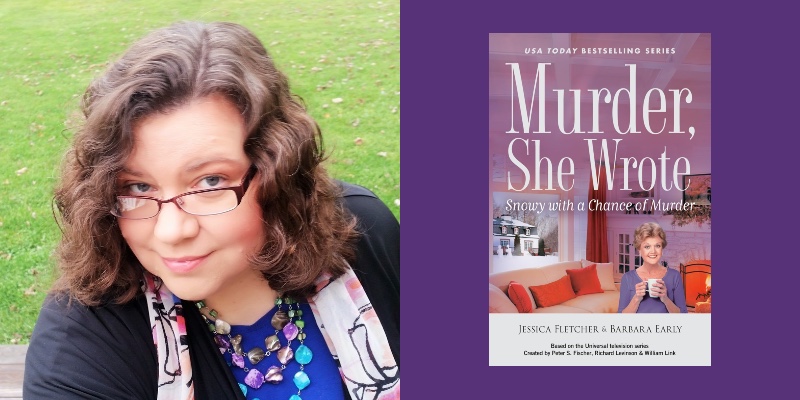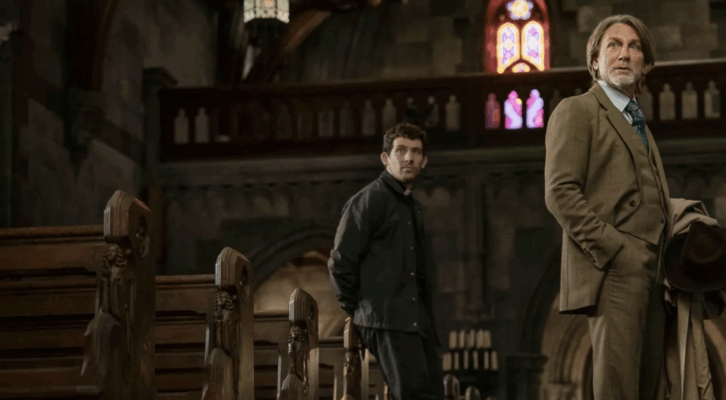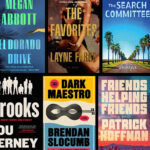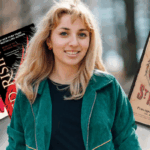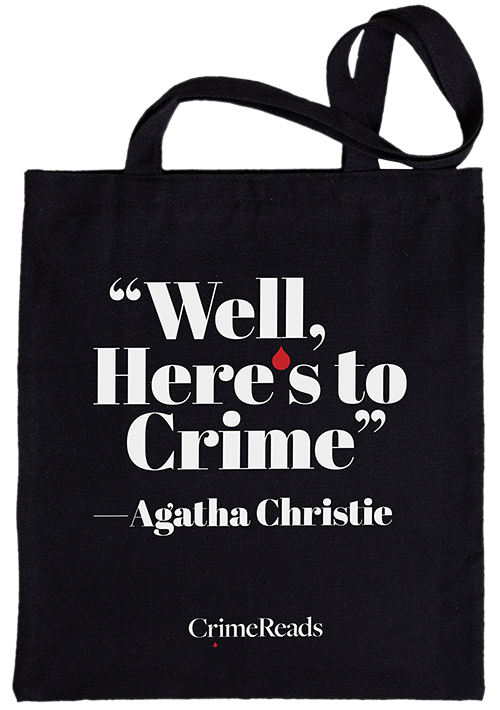Few characters are as beloved in the hearts and minds of audiences as Murder, She Wrote’s Jessica (J.B.) Fletcher.
As portrayed by the iconic Angela Lansbury, Jessica Fletcher—a widowed English teacher turned unwitting mystery novelist and amateur sleuth—was first introduced to television viewers in 1984. Murder, She Wrote ran for twelve seasons and four telefilms, inspiring a book series that now boasts sixty titles, the first forty-plus of which were written by Donald Bain (often in collaboration with his wife, Renée Paley-Bain). Following Bain’s death in 2017, the reins were passed down to Jon Land and, later, Terrie Farley Moran.
The latest entry, Murder, She Wrote, Snowy with a Chance of Murder (Berkley; March 18, 2025), brings Barbara Early into the fold; she and Moran are expected to share writing duties moving forward. An engineer by degree and practice, Early developed an aversion to math after a yearslong barrage of numbers and subsequently undertook a variety of other roles: secretary, schoolteacher, paster’s wife, and even amateur puppeteer. Then, she found herself drawn to crime fiction and penned both the Vintage Toyshop series and the Bridal Bouquet Shop Mysteries (the latter written as Beverly Allen).
Early’s MSW debut finds Jessica Fletcher homebound in Cabot Cove, Maine after a fall down the stairs lands her in a wheelchair. Under the watchful eye of a live-in caretaker, Jessica nevertheless catches wind of several mysteries that have cropped up around town—including an enigmatic vagrant nicknamed the “Bologna Kid,” a murder down by the docks, and an artist whose anatomically correct snow sculptures can be seen through her living room window. Despite the confines of her circumstances, Jessica’s mind is as sharp as ever, meaning she may just find herself a sitting duck for a killer whose only hope lies in silencing her.
Now, Barbara Early discusses the daunting, delightful task of doing justice to Jessica Fletcher and friends …
John B. Valeri: Tell us how your involvement with the Murder, She Wrote books came about. What is your history with the franchise – and did that familiarity make the undertaking daunting or easier?
Barbara Early: I was in college when Murder, She Wrote first debuted on television, and I’ll admit, I missed the early seasons. I know I was a fan by ’86 because I recall trying to stay up ‘late’ to watch it—I had a job an hour’s commute from my apartment that started at 6am. I caught up in syndication and enjoyed introducing her to my daughter through the DVDs years later.
I suppose one of the first things that drew me to the series was a certain similarity to Miss Jane Marple, whom I had enjoyed since borrowing my first Agatha Christie from the library in my early teens. From my point of view, at the time, both were engaging and unexpected amateur sleuths, underestimated on the basis of their age and gender, and I relished watching them prove their critics wrong! (Of course, now I appreciate the difference in the ages of the two!)
That familiarity helped when I was asked if I might be interested in chronicling Jessica’s adventures with Terrie Moran, whom I had met at Malice Domestic years earlier when we were both at the beginning of our writing journeys. I would have quickly declined if I had never seen the series or wasn’t a fan. But it was daunting at the same time. To write words that readers would “hear” in the voice of Angela Lansbury—it’s kind of a heady thing—and I think it comes with almost a duty of care. I was both elated and terrified when my proposal for this first book was enthusiastically received by the publisher, and while writing it, I took great pains to bring readers a genuine voice, and not step too far afield of the Jessica they’ve come to know and love.
JBV: Jessica Fletcher (as played by Angela Lansbury) is not only an iconic character who readers/viewers feel protective of, but an actual property owned by Universal. In what ways was this both a help and a hindrance to the generative process? How did you endeavor to balance expectations with your own creative and stylistic sensibilities?
BE: Because it’s my goal to recapture Jessica Fletcher as originally portrayed, and not try to reinvent her, I haven’t felt hindered at all. I wouldn’t dare try to change her; she’s an icon. And that also goes for the rest of the “returning cast.” I expended substantial effort trying to get their characterizations and voices as authentic as I could and to make the transition between authors as seamless as possible. As far as my own creative sensibilities are concerned, there are always new characters to add and new stories to tell within that framework. I can’t say I felt overly confined.
JBV: Snowy with a Chance of Murder finds Jessica largely housebound and using a wheelchair after suffering a fall. In what ways does this set-up heighten suspense, if more cerebrally than action-oriented – and how does it serve as an homage to Rear Window and the MSW episode “Crossed Up” (which found Jessica confined to bed, albeit under different circumstances)?
BE: To me, Murder, She Wrote has most often been more cerebral than action-oriented. Contrary to many other detective shows of the time period (which almost always ended in a gunfight, explosion, car chase, or defusing a bomb), Jessica Fletcher generally bucked that trend by thinking and talking her way to the bottom of a case. I can only think of a few exceptions.
To be fair, the idea to put Jessica into a wheelchair for the majority of this book was inspired more directly from my own mobility challenges. I was aware of “Crossed Up,” for sure, and reference it directly when Grady wonders if he can come take care of her—and when Jessica questions if she really wants that! (Fifty ways to eat canned tuna, anyone?)
But I was really intrigued and influenced by Hitchcock’s structure in Rear Window. There, Jimmy Stewart’s character, also laid up from injury, starts watching all the disparate but curious little vignettes that he sees through his binoculars. Some are harmless. Others are more sinister. Not all are connected, but they play out before the viewer’s eyes long before the murder happens. The suspense is created because the viewer knows at least some of this information will be part of a bigger plot, but it’s up to them, along with Stewart, to ferret out the meaningful bits from the amusing chaff around it.
In Snowy with a Chance of Murder, the information comes not only from what Jessica sees through her front window, but also from the tidbits that her friends and neighbors bring in when they drop off treats and stay for a little tea and gossip around her kitchen table. Admittedly, it’s a slightly different structure than some mystery readers are used to, in that many of the clues are “frontloaded,” presented before the crime takes place. At the beginning, the mystery isn’t whodunnit, as much as it is, who is moving into this neighbor’s house when they are away? What is he up to? Why is he doing it? And does he have anything to do with the other curious things that are happening around Cabot Cove?
JBV: Jessica’s caretaker, Alice, is an author in the making – which affords Jessica the opportunity to share some of her writerly wisdom. In what ways does this aspect of their burgeoning relationship help to reveal facets of each character – and how does the inclusion of extracts from Alice’s work-in-progress not only exemplify Jessica’s tutelage but echo the theme(s) of the story?
BE: Jessica doesn’t often get many opportunities to talk about the craft of writing, which is a bit of a shame, because it seems like readers would like to hear more about it. So to include an aspiring writer was a fun opportunity. As Jessica begins to feel affection for this young woman, it tends to bring out the motherly aspects in Jessica—who, while she never had children of her own, helped raise Grady when his parents died.
Without giving away too much of the plot, I think it’s safe to say that, like most writers, especially beginners, Alice draws heavily from her life. To include this bit of a story within a story allows the reader to delve more deeply into her point of view and perhaps infer some details about her past that she might not overtly share.
JBV: I would assume that much of Jessica’s mentorship is based on your own writing practices. Please share how your approach to craft informs hers. In what ways does the application of these habits enhance your ability to manage multiple story threads – e.g. two murders, a mysterious vagrant, and risqué snow art – so that they come together in ways that are meant to satisfy and surprise readers?
BE: Most professional writers have many common practices, which are probably a lot less glamorous than many readers might imagine. We strive toward artistry, but because we also write to deadlines, we don’t have the luxury of waiting for the muse to strike or polishing the same manuscript for ten years. Even if we’re having a bad day, we get the story down on paper. It can be ugly at first, but then we pretty it up as best as possible, while watching its due date approach much too quickly on the calendar. When it comes, we say a brief prayer and hit SEND. After that, the editors help in the process.
As far as managing multiple story threads, I’m a flexible outliner. Some of the threads were woven in at the beginning, some were added later after a spark of inspiration. As the writer, I see a tapestry full of knots and tangles, but when readers follow just the finished side, somehow they see Jessica and her friends moving around Cabot Cove. How that works is a mystery beyond my comprehension.
JBV: You incorporate abundant references to characters and storylines from previous installments, some of which crossover between the television series and novels while others exist solely in the books. Tell us about the intersection of tradition with technology and tourism. Why is it important that Cabot Cove is brought into the present rather than remaining in the past?
BE: In some ways, people are the sum of their experiences. The same must be true for fictional characters, and including references to Jessica’s past experiences throughout the book does two things: it goes a long way in ensuring that I get her character right, and it cues the reader that, yes, this is the same Jessica they already know. As a bonus, the flashes of memory give the avid fan little Easter Eggs to look for and try to figure out which episode or book that memory comes from.
As far as bringing Cabot Cove into the present, it’s not a decision for one book, but one that has been made throughout the series. All long-running series have to decide what to do with the passage of time, and they all manage it differently. Nancy Drew had a very exciting eighteenth year—and there is no way all her adventures could have happened in 365 days. Sue Grafton initially set her first Kinsey Millhone book in the present, when she wrote it in the 80s, but as the series progressed, she kept the clock moving slowly for her character, keeping her character in that decade.
The MSW books are set in the present, so new technologies enter as they are developed, but the characters themselves either stay the same age or are aging very slowly. The advice I was given: as much as possible don’t include numbers and don’t do the math.
As for the increase in tourism, population, and development in Cabot Cove since the end of the television series? All have increased throughout the book series, going way back at least to the replacement of the “do-nothing” mayor Sam Booth. Much of the growth seems to take place at the edge of town or just outside the town limits, allowing Cabot Cove to remain the charming seaside community readers know and love. Meanwhile, ongoing development promises to do more than generate heat at town meetings; it also has potential to generate much conflict—and conflict is the seed for good fiction, especially a murder mystery.
JBV: The MSW books are considered cozies, meaning there are certain restrictions in terms of what can and can’t be seen or said on the page. In what ways do these limitations (no gratuitous violence, sex, or language) inspire you to be more imaginative? Please share an example from Snowy with a Chance of Murder.
BE: I am very much a cozy writer and a cozy reader. Nothing I write contains gratuitous violence, sex, or language, so I really didn’t feel any added limitations. It’s not that I’m a prude as much as I’ve experienced some darker seasons in real life and have no desire to revisit those times in fiction. I’ve found that to be a trend among many cozy readers. They’re not naïve prudes, aghast and clutching at their pearls, but often they too have experienced difficult things, and they’re not entertained by graphic content.
That being said, at least one murder in the story was very gory and violent, there are huge naked snow sculptures, and a little cursing goes on. The key to keeping it cozy is point of view. For example, Jessica doesn’t describe the sculptures, rather, they are ‘described’ by the reactions of others, (for example, the mermaid sculpture and her lack of…shells). And while Jessica might note curses of others, she feels no compunction to repeat them.
JBV: Leave us with a teaser: What comes next for you and Jessica?
BE: I am currently working on edits for my second MSW book, with a planned release in 2026. Without giving away too much, I will say that Jessica travels (with Cabot Cove friends) and may encounter a few fun characters she hasn’t seen since the television series.

